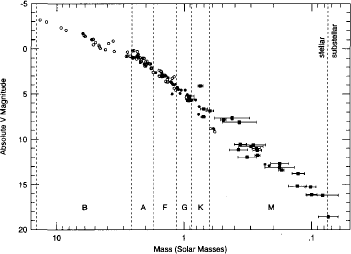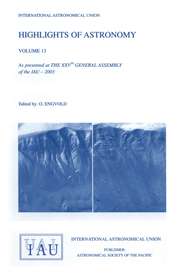No CrossRef data available.
Article contents
The Mass-Luminosity Relation From Binaries
Published online by Cambridge University Press: 14 August 2015
Extract
What is known about the masses of main-sequence stars from the analysis of binary orbits? Double-lined eclipsing binaries are the main source of very precise stellar masses and radii (e.g. Andersen 1997), contributing more than 100 determinations with better than 2% precision over the range 0.6 to 20 Mʘ. For lower-mass stars we are forced to turn to nearby systems with astrometric orbits (e.g. Henry et al. 1993). Not only is the number of good mass determinations from such systems smaller, but also the precision is generally poorer. We are approaching an era when interferometers should have a major impact by supplying good astrometric orbits for dozens of double-lined systems. Already we are beginning to see the sorts of results to expect from this (e.g. Torres et al. 1997).

Figure 1. Mass vs. absolute V magnitude for eclipsing binaries (circles) and nearby astrometric binaries (squares)
Figure 1 is an updated version of a diagram presented by Henry et al. (1993, their Figure 2). It shows the general run of mass determinations from about 10 Mʘ down to the substellar limit near 0.075 Mʘ. Ninety of the points in Figure 1 are for eclipsing binary masses from Andersen’s review (1991) and are plotted as open circles. The results for eclipsing binaries published since 1991 are plotted as 30 filled circles, adopting the same limit of 2% for the mass precision. In most cases the uncertainties are similar to the size of the symbols. Especially noteworthy is the pair of new points for CM Draconis (Metcalfe et al. 1996) with masses near 0.25 Mʘ. Together with the points for YY Geminorum near 0.6 Mʘ, these are the only M dwarfs that have precise mass determinations. For the most part we are forced to rely on nearby stars with astrometric orbits, to fill in the M dwarf region of the diagram. We have used filled squares in Figure 1 for 29 such systems from Henry et al. (1993), updated using 14 new parallaxes from Hipparcos and 4 from the new Yale Parallax Catalog (1995). Gliese 508 is not included, because it is now known to be a triple, while Gliese 67AB, 570BC, and 623AB are not included because there are not yet any direct measurements of the V magnitude difference for these systems.
- Type
- II. Joint Discussions
- Information
- Copyright
- Copyright © Kluwer 1998


